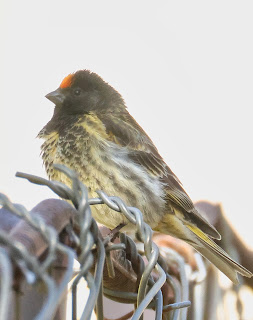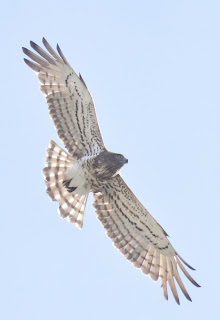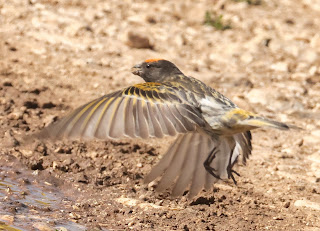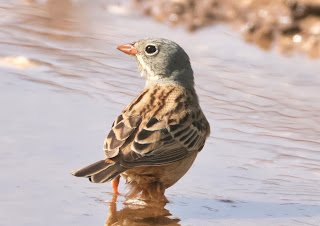I flew from Manchester with the family, Dawn and Autumn and stayed in the Boğazkent district near Belek and booked one long tour with Vigo Tours that included a full days birding in the mountains and then a night time tour for the owl.
For anyone wanting to combine a decent birding trip with a family focused holiday, specifically a holiday with a small child this is perfect. We chose an all inclusive resort called Shearwood Dreams, witch offered a selection of swimming pools, a fairground and waterpark full of slides for Autumn. The main reason we chose this part of Türkiye was to see the brown fish owl.
Antalya, offers excellent birding opportunities with a diverse range of species, including both resident and migratory birds.
Key areas for birdwatching include Iskele Parki, the Taurus Mountains, and areas around Side ancient ruins. April and May are generally good months for birding due to the spring migration.The magnificent brown fish owl is one of the rarest owls in the Western Palearctic and is critically endangered in Europe. They are restricted to a small, disjunct range in southern Turkey and are known for its nocturnal habits and preference for mountainous habitats with mature pine trees bordering clean freshwater rivers or pools.
Red-fronted Serin: Brown Fish owls have quite a wide distribution globally, throughout India up to Thailand, but this is probably a subspecies and has some visual differences, such as being generally more pale. So, should this bird be genetically split from the Asian population and become its own species.
Vigo Tours offer two different guided tours to see the fish owls, one is where they take you out on a private boat on to Oymapinar Lake near Manavgat. This was offered to me at an extortionate rate, probably because they were asking for a minimum of four participants, they wanted 450€.
The bird was thought to be extinct until 2004 when a small population was rediscovered at Oymapinar lake near Manavgat. The owl is difficult to spot due to its nocturnal nature and preference for remote, mountainous areas.
True to its name, the brown fish owl spends a lot of its time fishing for food, it has buffy feathers around its facial disc, and a lovely medley of browns, blacks, and creamy beiges all over its body. It has striking bright yellow irises. Like the Eurasian eagle-owl it has feathery ear tufts, which aren't ears at all, but rather feathers that look like the ears of some mammals. These protruding feathers can aide in communication and camouflage.
Vigo Tours offer two different guided tours to see the fish owls, one is where they take you out on a private boat on to Oymapinar Lake near Manavgat. This was offered to me at an extortionate rate, probably because they were asking for a minimum of four participants, they wanted 450€.
The other tour is a night time tour offering observations through the night into the early hours of the morning. They take you to the fish farm near Samyeli canli Alablik located along teh Manavgat River and use powerful touches to find the owls roosting and hunting around the fish farms.
White-throated Robin (male): I spent hours scanning the pine trees that dotted the banks of the lake and searching from the top deck of the boat around every crevasse we sailed past. Well, my hard work paid off as I saw the owl from some distance and as we sailed past I shouted 'OWL' the tour guide came running up from the bottom deck and promised me he will turn the boat around and we can hover beside it for some photos.
White-throated Robin (female): I was absolutely thrilled to bits, my number one target bird in the bag. It was a real rush of adrenaline. The whole boat was amazed and even Autumn was getting excited, probably feeding off m own excitement, but it was sweet to see.
Black-headed Bunting: From here we took the road less travelled taking us up further up the mountain range stopping off occasionally as some known areas for lesser woodpecker, Krueper's nuthatch, rock nuthatch and masked shrike.
I enquired with Vigo Tours what my chances might be if I booked a general tour of Oymapinar Lake, a trip with no focus on the owls at all but one that simply visits the lake. I got a couple of responses that were surley, if a little hostile, informing me that I had little to no chance of seeing them.
Anyway I booked on and informed Vigo Tours that I was happy to take my chances and take the gamble. This boat tour cost 40€ for me and Dawn and 20€ for Autumn. Peanuts compared to the proper owl tour that Vigo were trying to upsell. Anyway, after a pleasant trip cruising around the lake, a nice spot of lunch and a splash about in the water with Autumn. I found the owl sitting between a deep, open fissure in the side of a steep stony outcrop.
White-throated Robin (female): I was absolutely thrilled to bits, my number one target bird in the bag. It was a real rush of adrenaline. The whole boat was amazed and even Autumn was getting excited, probably feeding off m own excitement, but it was sweet to see.
Short-toed Snake Eagle: A few days laster I embarked upon my full days bid tour, which included the night time owl tour. The tour began at sunrise, taking advantage of the first light of day when many bird species are most active. I took a 30 minute taxi (50€) to meet Mehmet my bird guide before heading up to the eastern Taurus Mountains.
It took us about an hour to reach our first destination, a cedar forest edged with a dense pine forest that ran alongside a small river, it was here that we saw the Syrian woodpecker, not easy to see only managing several short views creeping up the trunks and a few breif flight view. This defiantly got me excited.
My guide was good, if quiet which is fine, although I would have liked more information as we progressed, where we were going, what target birds were next. A bit of context about the ares we were visiting.
Horned Lark: The Taurus Mountains feature a large range of diverse habitats from Mediterranean scrub and forests to alpine zones, creating a biodiversity hotspot. These habitats include juniper-fir-oak forests, cedar forests, pine forests, and even maquis formations, with vegetation varying based on elevation and slope aspect.
The higher we went the more alpine pastures and grassland and wildflower meadow habitats there were. Large areas of flat, short vegetation often encircled by steep rocky formations. It was these areas that attracted birds such as the horned lark, buntings species that included black-headed, corn and Cretzchmar's.
Black Redstart: Mehmet allowed me to go off and explore a little, which gave the some good photographic opportunities stalking down black redstarts and trying to pick out olive tree warblers.
Horned Lark: The Taurus Mountains feature a large range of diverse habitats from Mediterranean scrub and forests to alpine zones, creating a biodiversity hotspot. These habitats include juniper-fir-oak forests, cedar forests, pine forests, and even maquis formations, with vegetation varying based on elevation and slope aspect.
The higher we went the more alpine pastures and grassland and wildflower meadow habitats there were. Large areas of flat, short vegetation often encircled by steep rocky formations. It was these areas that attracted birds such as the horned lark, buntings species that included black-headed, corn and Cretzchmar's.
Black Redstart: Mehmet allowed me to go off and explore a little, which gave the some good photographic opportunities stalking down black redstarts and trying to pick out olive tree warblers.
I really liked how much Mehmet took the time to feed the stray dogs and play with them. He has a good, kind heart.
White Wagtail: We past several Yörük people, a group of nomadic shepherds that have traditionally practiced transhumance of moving their flocks of sheep and goats between summer and winter pastures. These nomadic shepherds, some of whom are among the last real nomads in Turkey.
White Wagtail: We past several Yörük people, a group of nomadic shepherds that have traditionally practiced transhumance of moving their flocks of sheep and goats between summer and winter pastures. These nomadic shepherds, some of whom are among the last real nomads in Turkey.
Ortolan Bunting: One area that we visited was the highest point of our journey took us to a small off-grid settlement, settled within the bare hills of Bozdağ Milli Parkı east of Konya. We drove straight to a well that fed a water trough.
This trough was leaking and forming small pools on the grassy patch under a tree. This water source was irresistible to the local birds and was pulling in small flocks of ortolan buntings, chaffinches, greenfinch, both serin species, European and red-fronted.
Its always a good day when you see an ortolan, they are small, sparrow-like bird with brown-streaked upperparts, pale orange underparts, and a greenish-grey head with a yellow chin and throat.
Red-fronted Serin: But it was here that my second most wanted target bird of Türkiye was, the red-fronted serin. These birds are known for their distinctive red forehead and sooty plumage, and they inhabit rocky and alpine slopes, preferring open areas with sparse vegetation. They are often seen in small flocks outside of the breeding season, foraging for seeds, fruits, and other plant material.
European Serin: We spent a good amount of time parked up watching the bird come and go, to be honest I could have spent all day here. The red-fronted were coming closer and closer as to where the rock sparrow.
Back down the mountain we stopped off in a wide valley surrounded by distinct woodland communities. Higher elevations support juniper and fir forests, with cedar forests becoming prominent and Karstic formations like depressions, plateaus, and valleys full of short scrub.
Red-fronted Serin: It was in this area we spent a lot of time looking for the sunning white-throated robin. This bird is larger than the European robin and resembles a small thrush.
Cretzchmar's Bunting: The breeding male has lead-grey upperparts, a black face with a white throat and supercilium, and orange underparts. The tail is black, as is the strong bill. Females are plainer, mainly grey apart from a black tail, hints of orange on the flanks, and some white throat streaks.
Mehmet told me that they are locally abundant, but we really struggled to find a one. In the end we found a nesting pair attending an active nest, probably one of the reasons they weren't as obvious in the area.
Red-backed Shrike: Other birds of not that we had during this part of the bird tour included, several red-backed shrike, hoopoe, rock nuthatch, crag martin, Sardinian warbler, rock sparrow, long-legged buzzard, isabelline wheatears, blue rock-thrush, yellow-billed cough, black-eared wheatear and short-toed snake eagle.
European Bee-eater: From here we drove during the early evening to the Manavgat River were we waited for it go go really dark before carrying out an intense search around the fish farms throughout the night into the early morning. If I'm being honest this was tough going, after a long day with no food, Mehmet was like a machine and kept going while I struggled to keep up
Spur-winged Lapwing: I used eBird to find some birding areas close to the hotel and came across a well watched area of farmland opposite a mosque called Ahmediye Cami. This place was great, off the beaten track and full of birds.
This trough was leaking and forming small pools on the grassy patch under a tree. This water source was irresistible to the local birds and was pulling in small flocks of ortolan buntings, chaffinches, greenfinch, both serin species, European and red-fronted.
Its always a good day when you see an ortolan, they are small, sparrow-like bird with brown-streaked upperparts, pale orange underparts, and a greenish-grey head with a yellow chin and throat.
Red-fronted Serin: But it was here that my second most wanted target bird of Türkiye was, the red-fronted serin. These birds are known for their distinctive red forehead and sooty plumage, and they inhabit rocky and alpine slopes, preferring open areas with sparse vegetation. They are often seen in small flocks outside of the breeding season, foraging for seeds, fruits, and other plant material.
European Serin: We spent a good amount of time parked up watching the bird come and go, to be honest I could have spent all day here. The red-fronted were coming closer and closer as to where the rock sparrow.
Back down the mountain we stopped off in a wide valley surrounded by distinct woodland communities. Higher elevations support juniper and fir forests, with cedar forests becoming prominent and Karstic formations like depressions, plateaus, and valleys full of short scrub.
Red-fronted Serin: It was in this area we spent a lot of time looking for the sunning white-throated robin. This bird is larger than the European robin and resembles a small thrush.
Cretzchmar's Bunting: The breeding male has lead-grey upperparts, a black face with a white throat and supercilium, and orange underparts. The tail is black, as is the strong bill. Females are plainer, mainly grey apart from a black tail, hints of orange on the flanks, and some white throat streaks.
Mehmet told me that they are locally abundant, but we really struggled to find a one. In the end we found a nesting pair attending an active nest, probably one of the reasons they weren't as obvious in the area.
Red-backed Shrike: Other birds of not that we had during this part of the bird tour included, several red-backed shrike, hoopoe, rock nuthatch, crag martin, Sardinian warbler, rock sparrow, long-legged buzzard, isabelline wheatears, blue rock-thrush, yellow-billed cough, black-eared wheatear and short-toed snake eagle.
Spur-winged Lapwing: I used eBird to find some birding areas close to the hotel and came across a well watched area of farmland opposite a mosque called Ahmediye Cami. This place was great, off the beaten track and full of birds.
Spur-winged lapwing where everywhere, I had a large flock of black-winged prats, a short-toed snake eagle. There were tons of crested lark, a few woodlark, a black-headed wagtail, little owl, laughing dove, turtle dove and white stork.
I visited this area a couple of times during my stay I took a 20 minute taxi (20€) and became somewhat of a local celebrity within the taxi driver community. By the end of the trip they all knew who I was and were fascinated with my choices of destinations all in the pursuit of birds.
I visited this area a couple of times during my stay I took a 20 minute taxi (20€) and became somewhat of a local celebrity within the taxi driver community. By the end of the trip they all knew who I was and were fascinated with my choices of destinations all in the pursuit of birds.
Another area I had the taxi driver drop me off was Iskele Parki, I came here almost everyday. This large expance of beach, dunes and costal scrub is found behind the Port Nature Luxury Resort Hotel & Spa. From the hotel there is only one way that ends at the beach, but you can drive or get the taxi driver to drive until the beach ends and there is a parking area where you can get out and explore the on foot.
Little-ringed Plover: This was a popular area with the locals, as they came to fish and park up to spend time on this part of the beach, the part that was far away from the crowded tourist beaches.
Little Owl: Also in the same area close to the Port Nature Luxury Resort Hotel & Spa is were the River Boğazkent opens up and forms a large fresh water marsh, with extensive reed beds flanked by mangroves and low lying trees. It was here I bagged a few little bittern and the super white-throated kingfisher.
Little-ringed Plover: This was a popular area with the locals, as they came to fish and park up to spend time on this part of the beach, the part that was far away from the crowded tourist beaches.
Little Owl: Also in the same area close to the Port Nature Luxury Resort Hotel & Spa is were the River Boğazkent opens up and forms a large fresh water marsh, with extensive reed beds flanked by mangroves and low lying trees. It was here I bagged a few little bittern and the super white-throated kingfisher.
Within the grounds of the hotel I found a tower hide with an information board about the ringing they do here and what birds they get in their mist nets. the hide overlooks the reed beds and the northen section of the waterbody.
Here is the links for Vigo Tours, probably not the best tour company that I have dealt with, but they can get you some really good birds.
Crested Lark: In summary Türkiye was great, fab weather, great birds an a really good place for a family holiday (with some birding shoehorned in).
Autumn has the best time splashing around in the pools and making friends at the kids disco. Dawn enjoyed the sunbathing the all inclusive drinks and the rest.






























